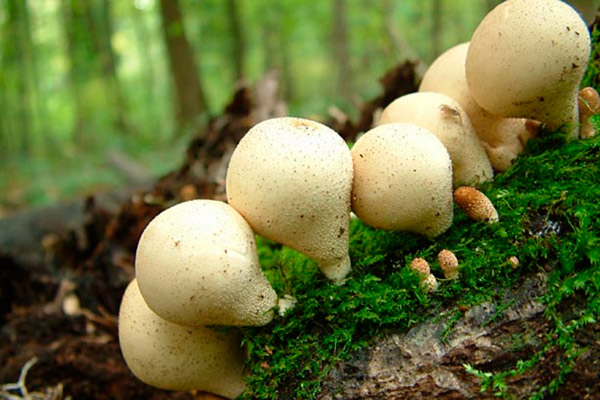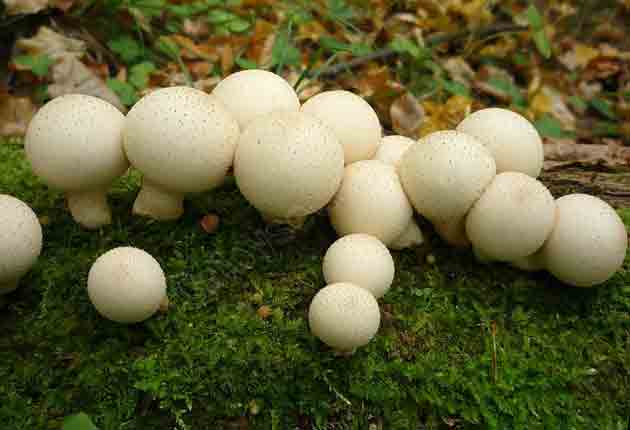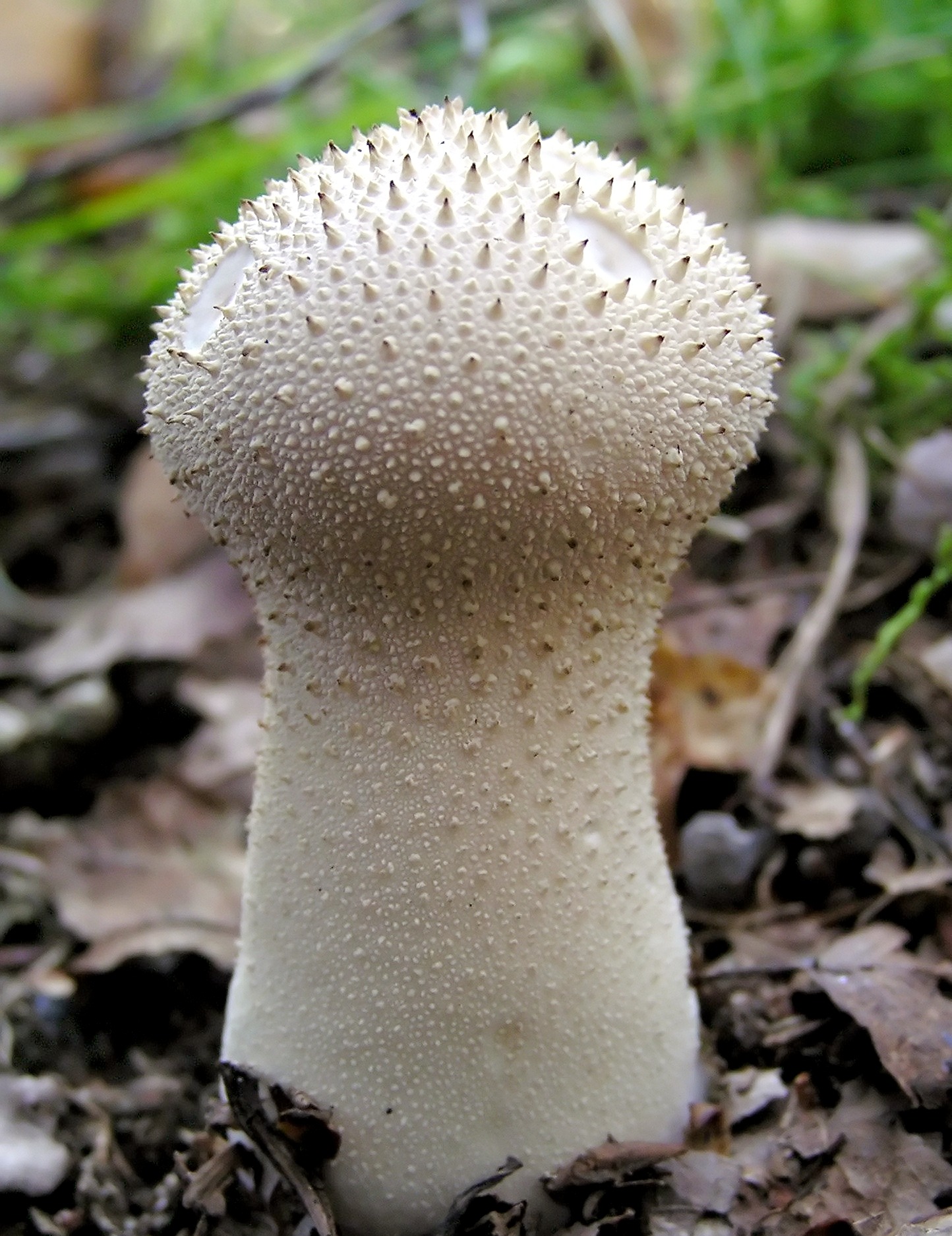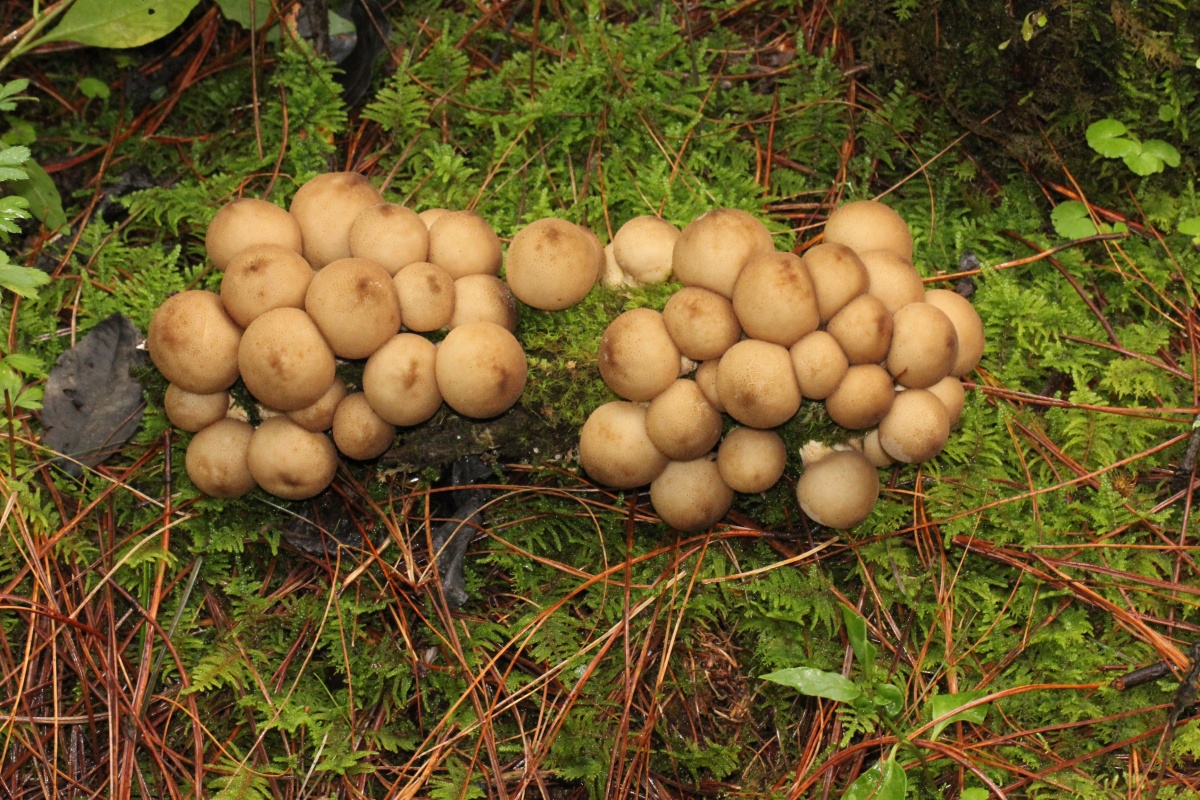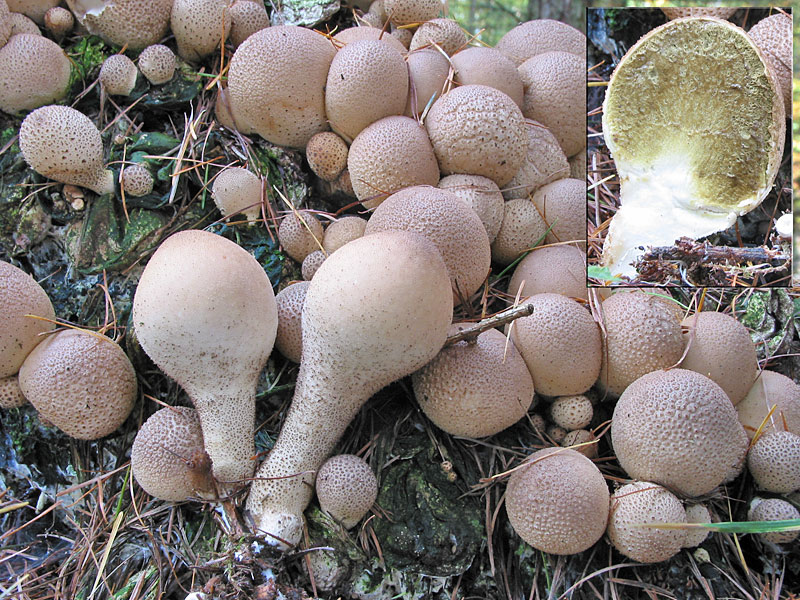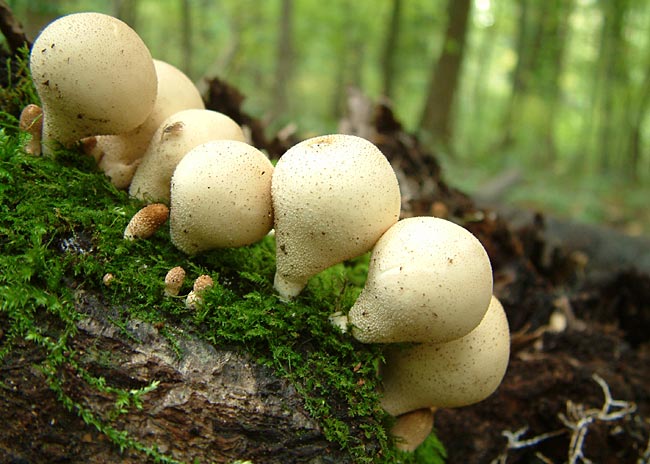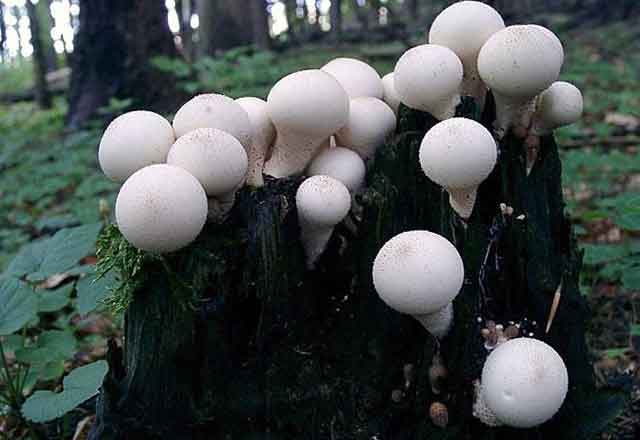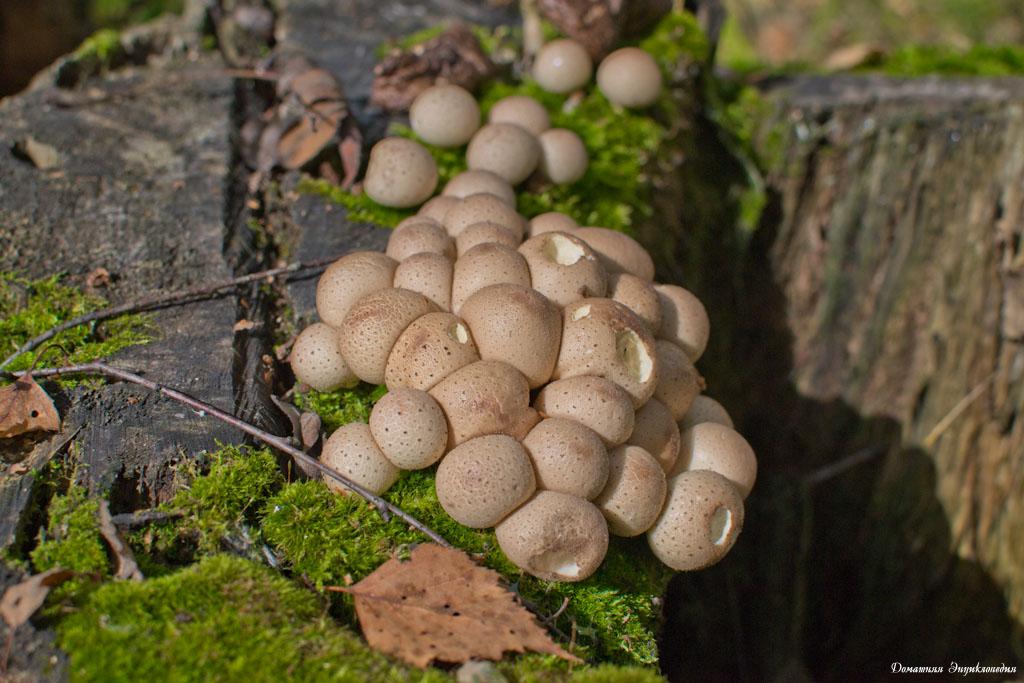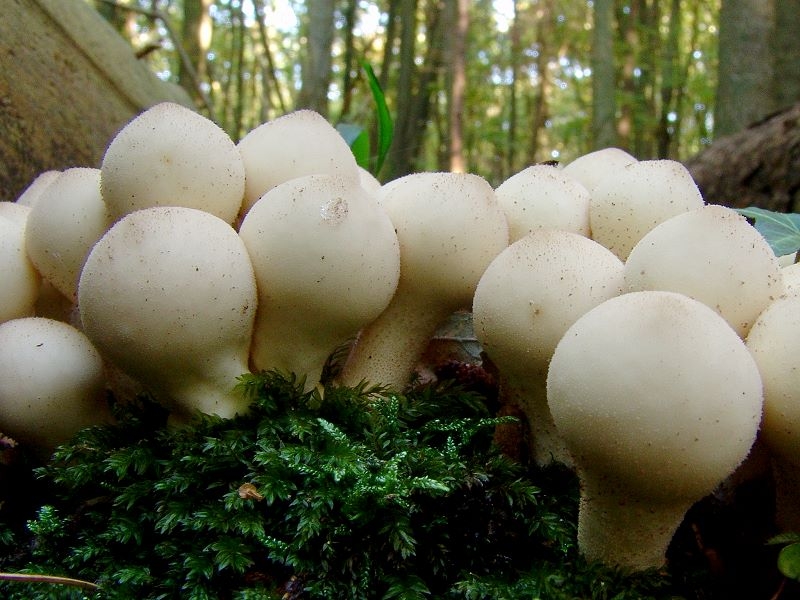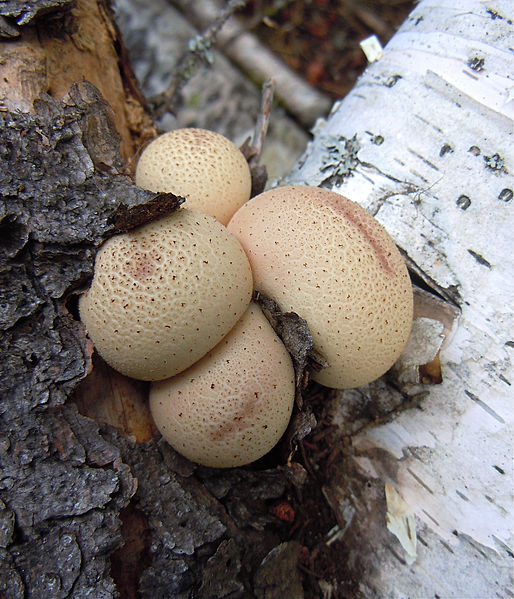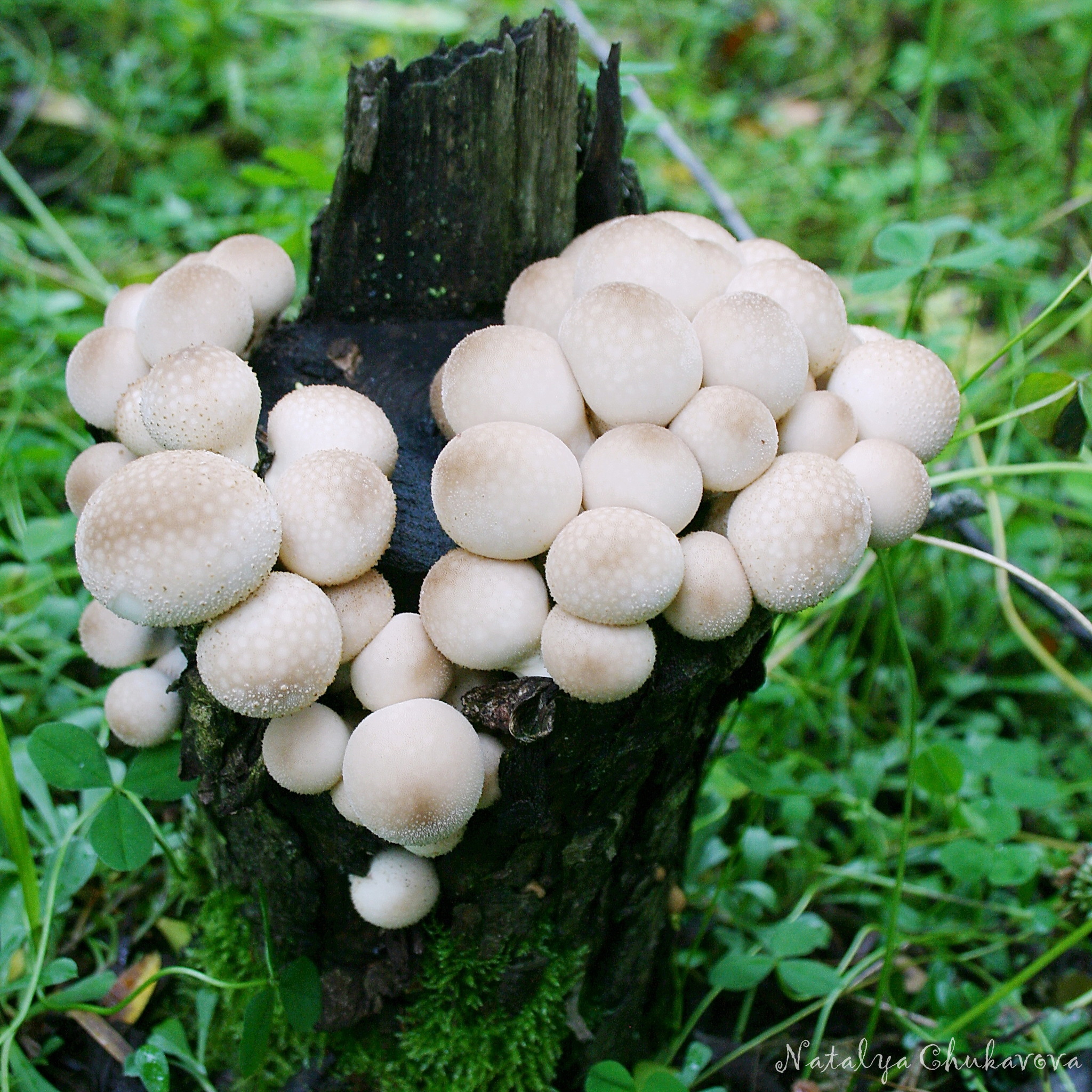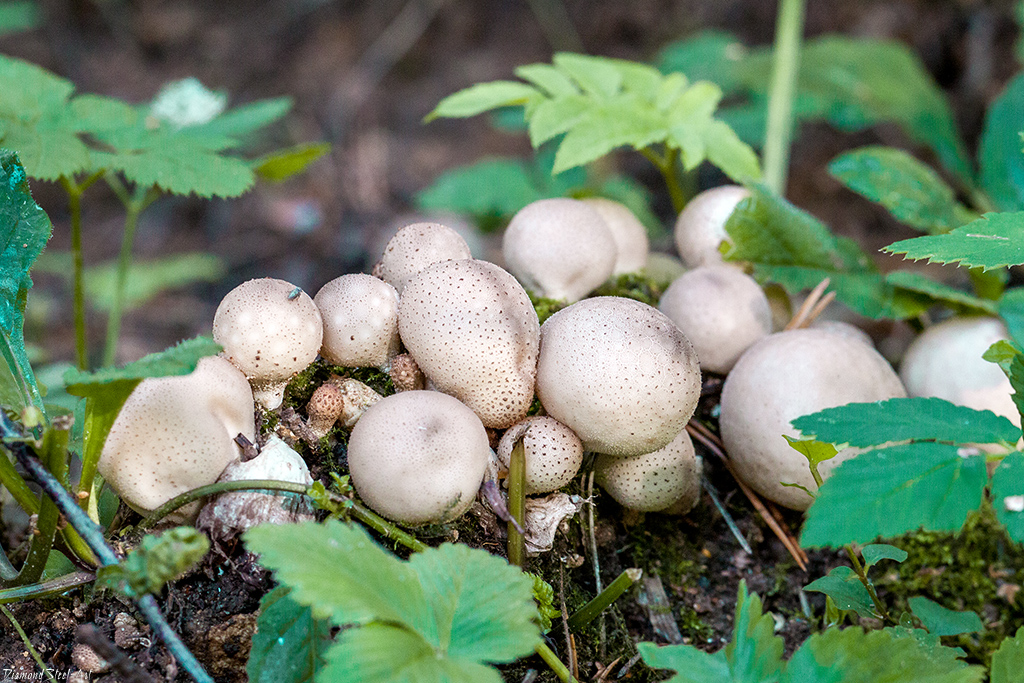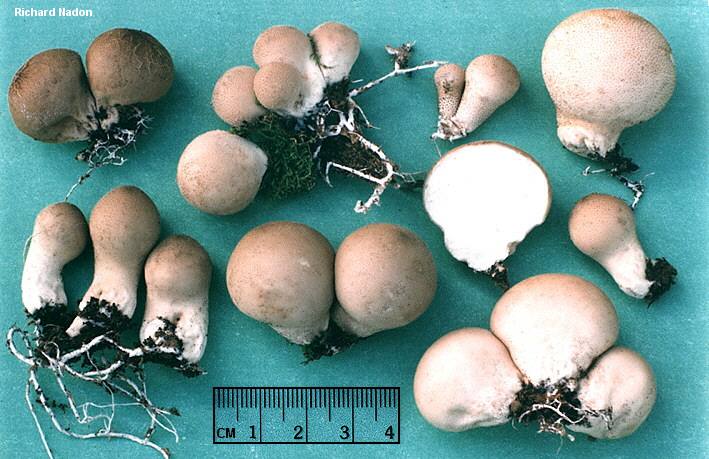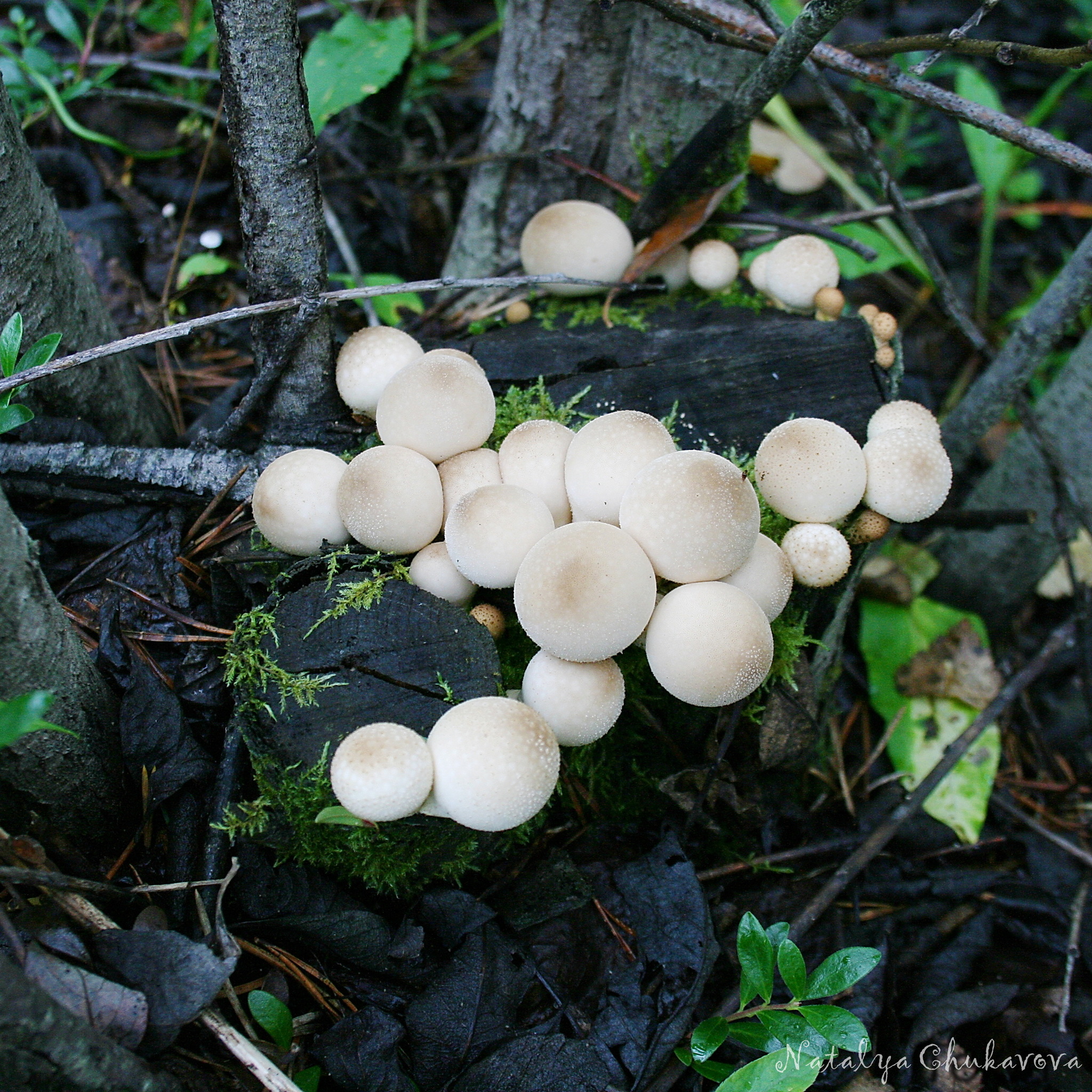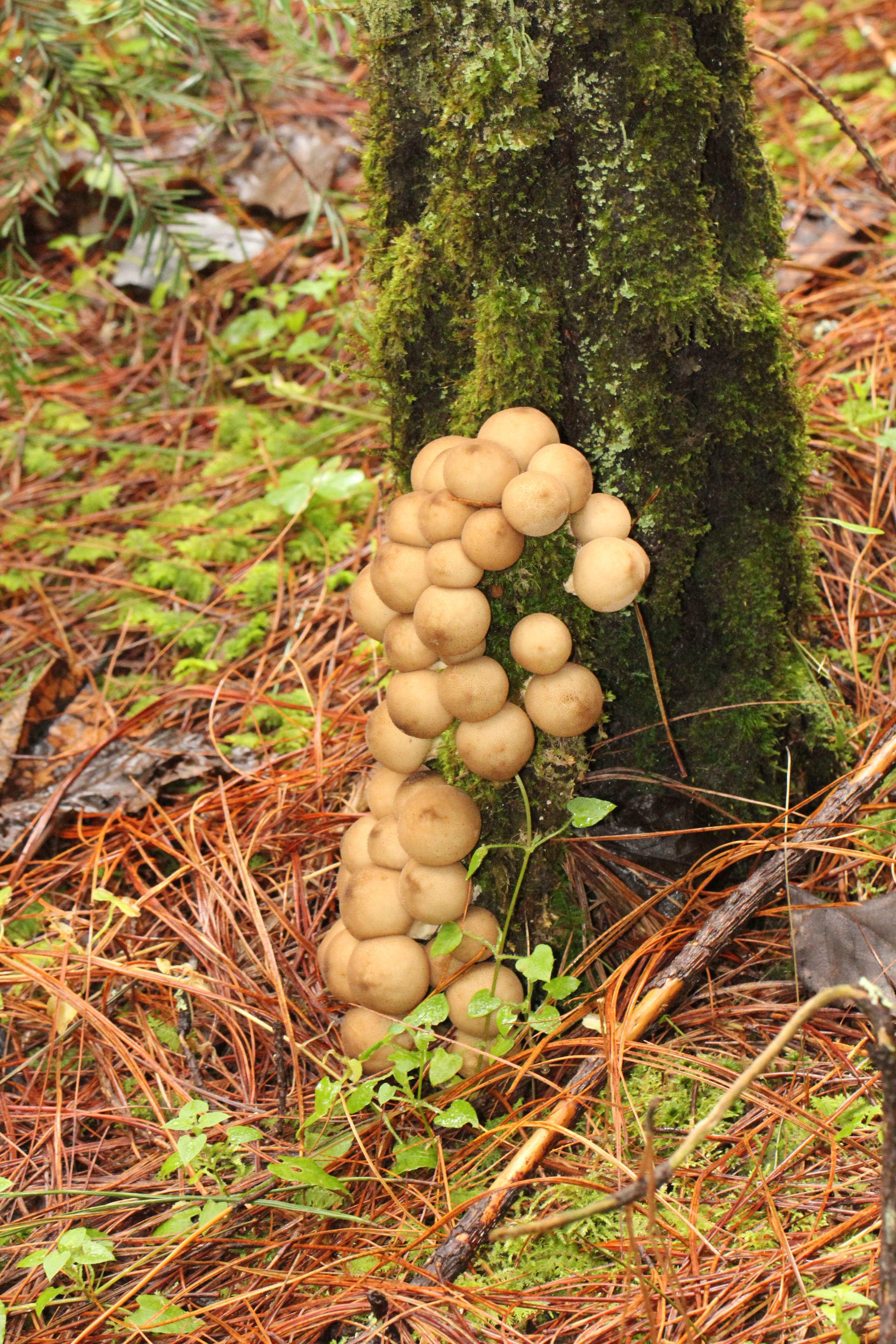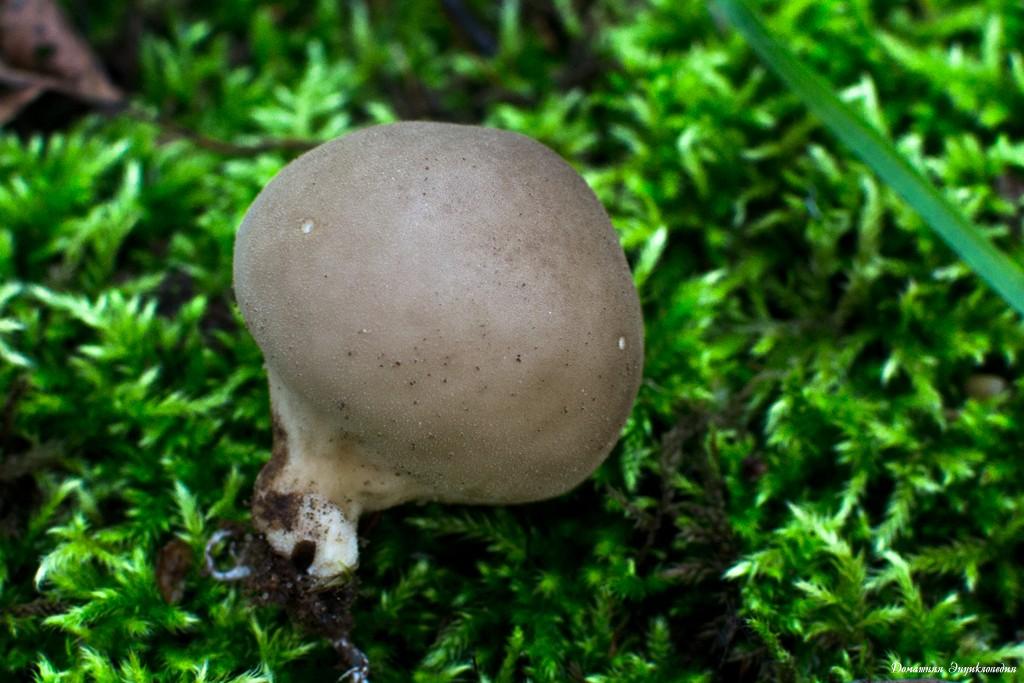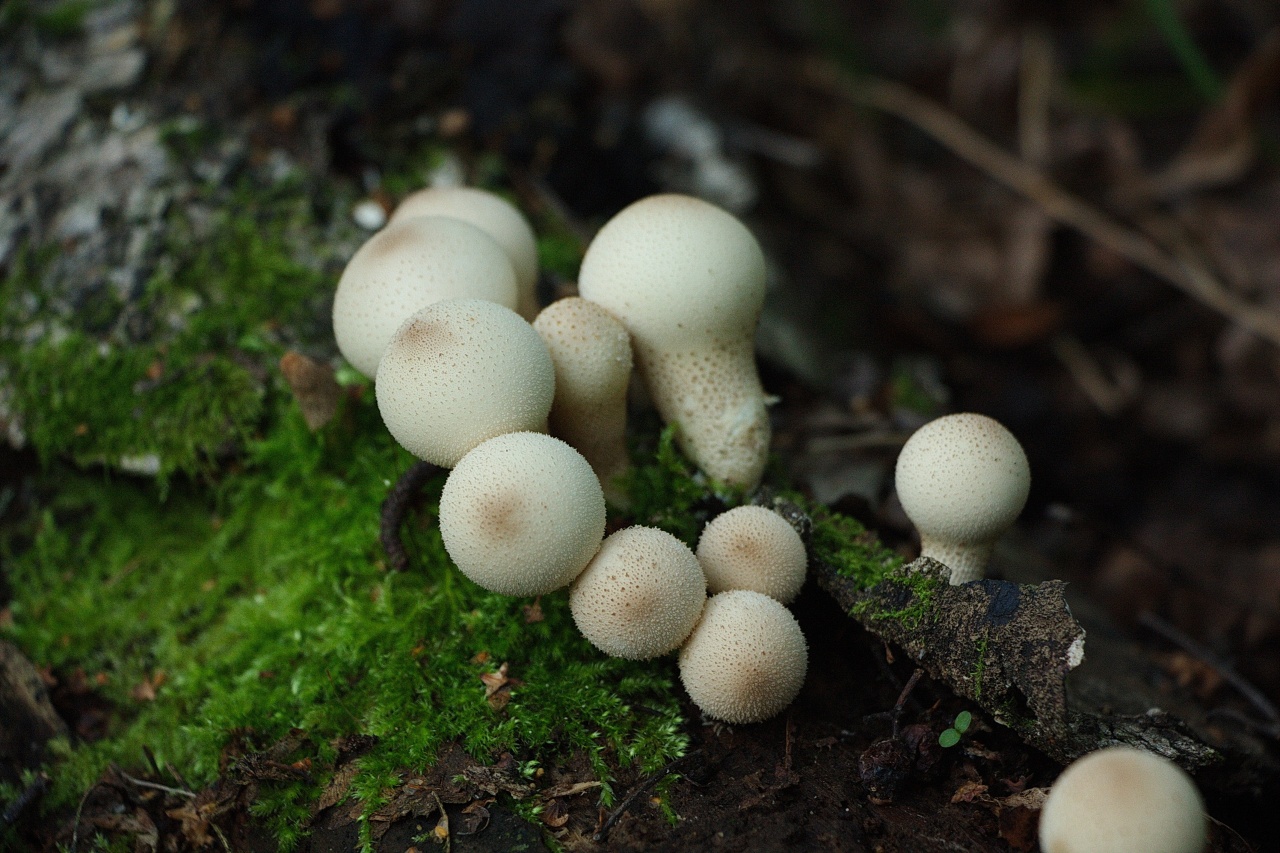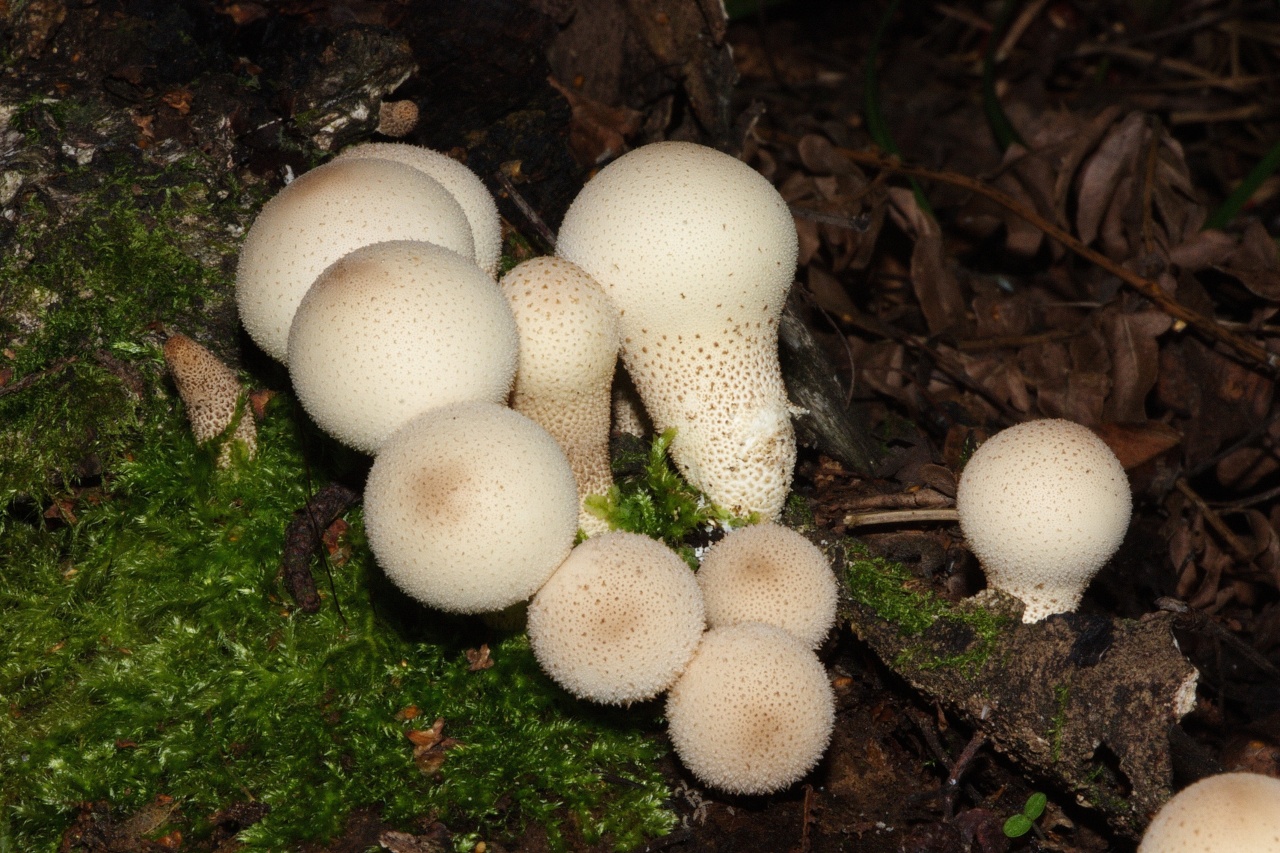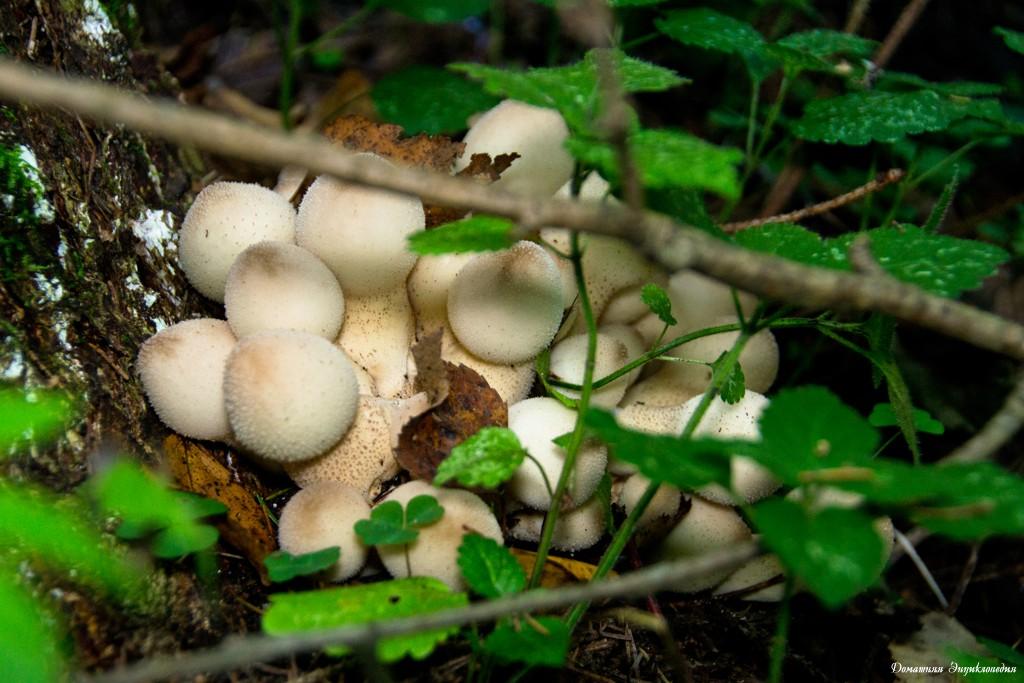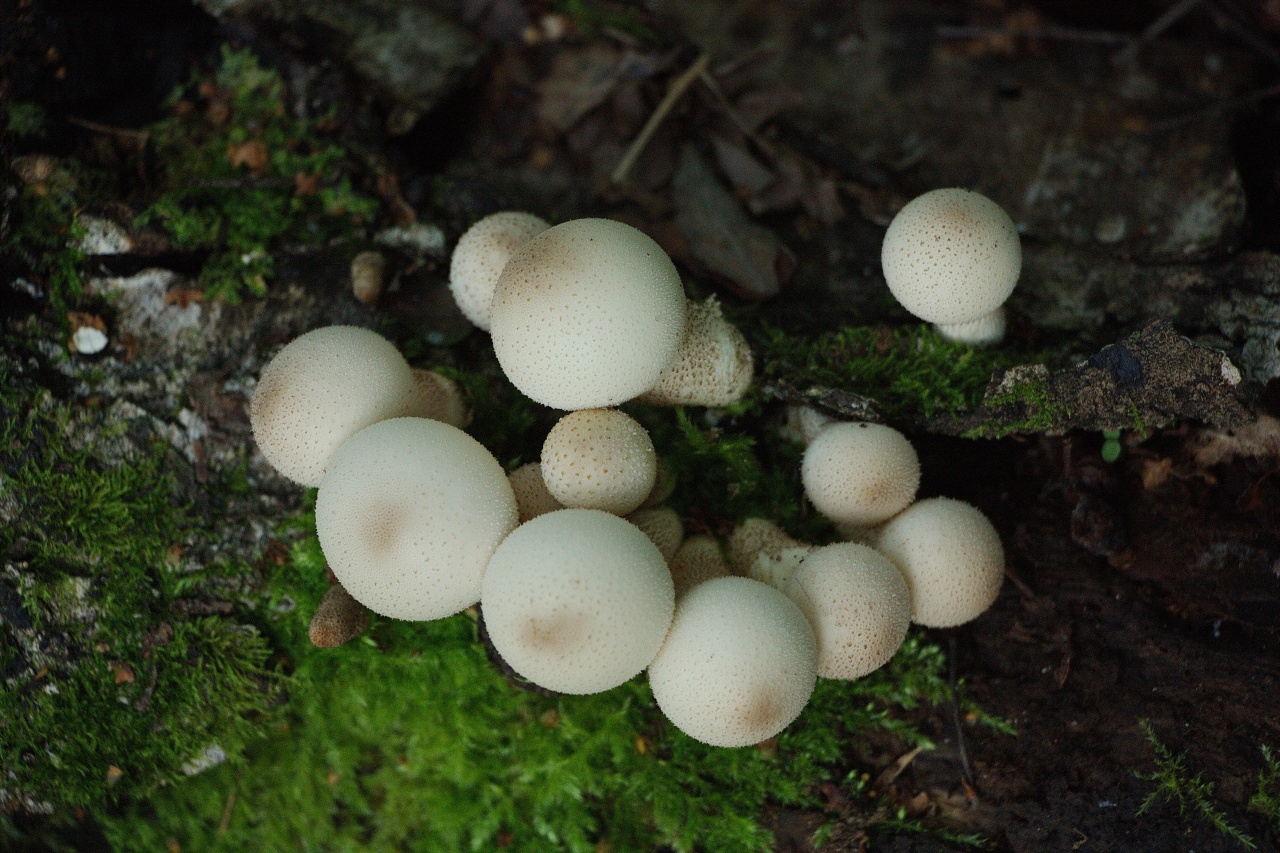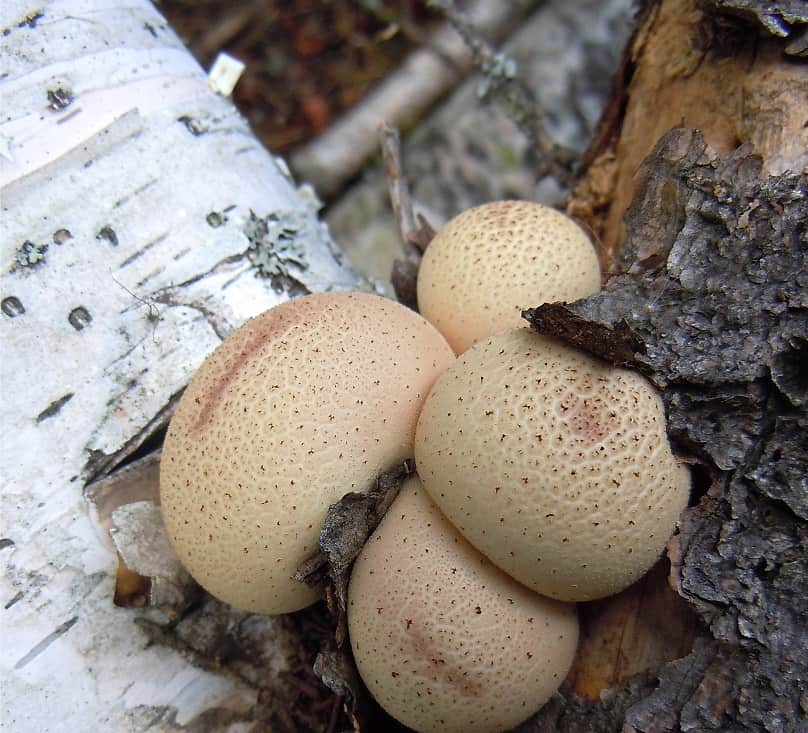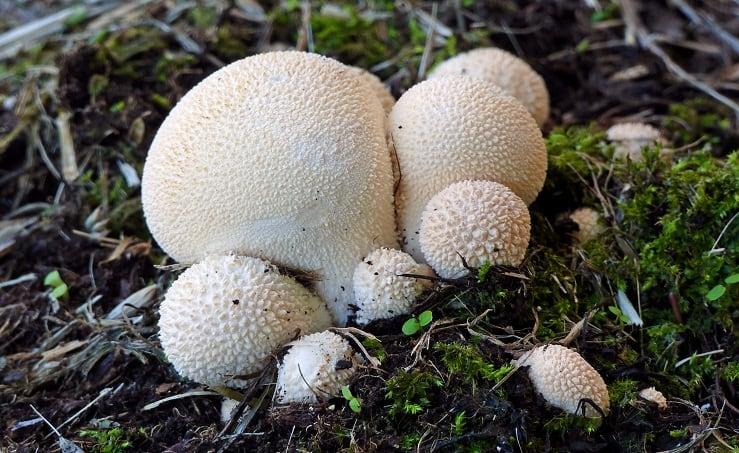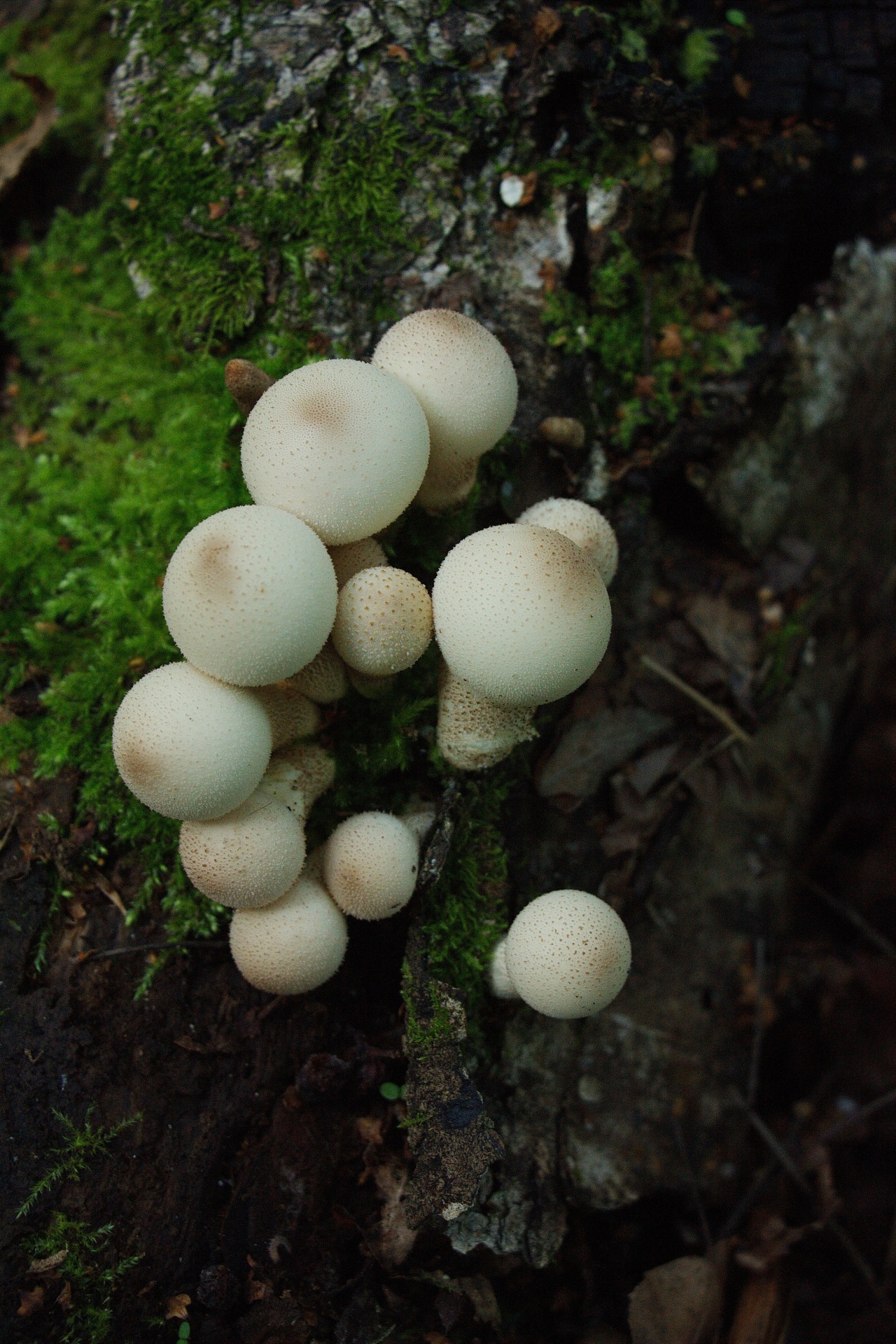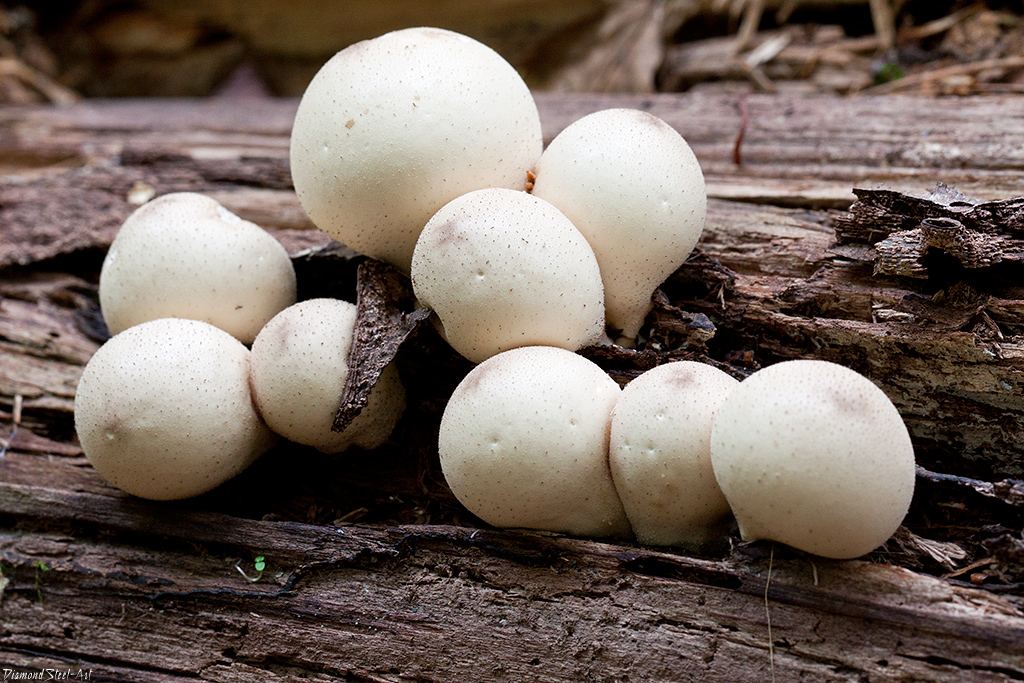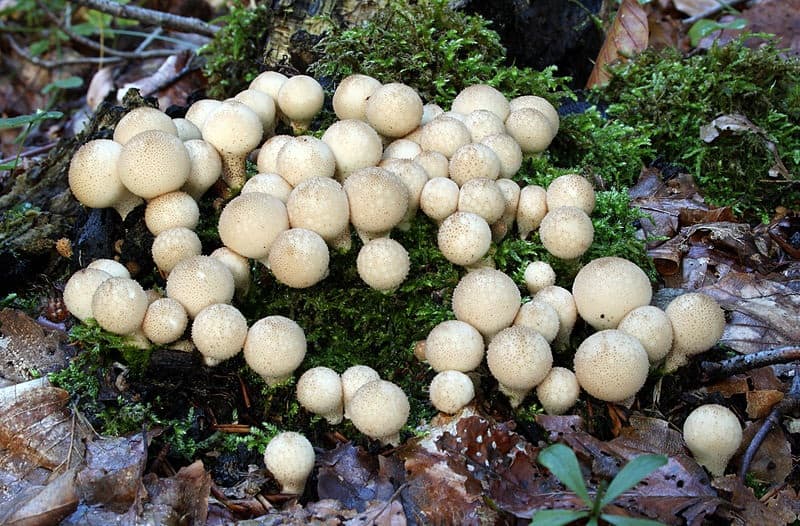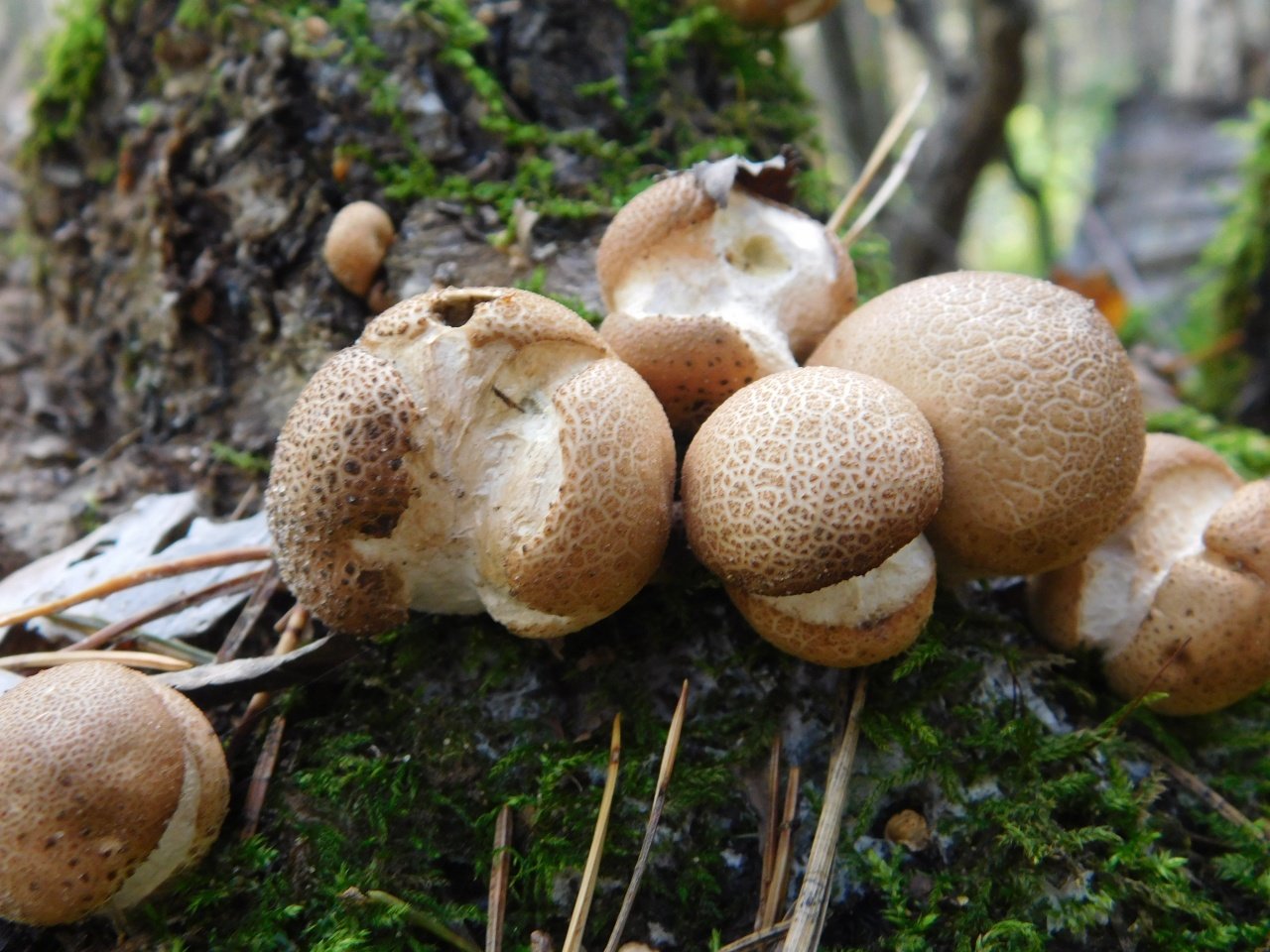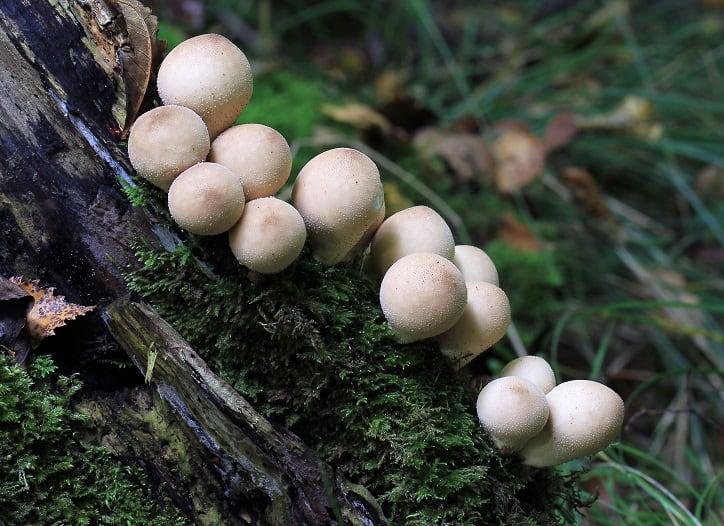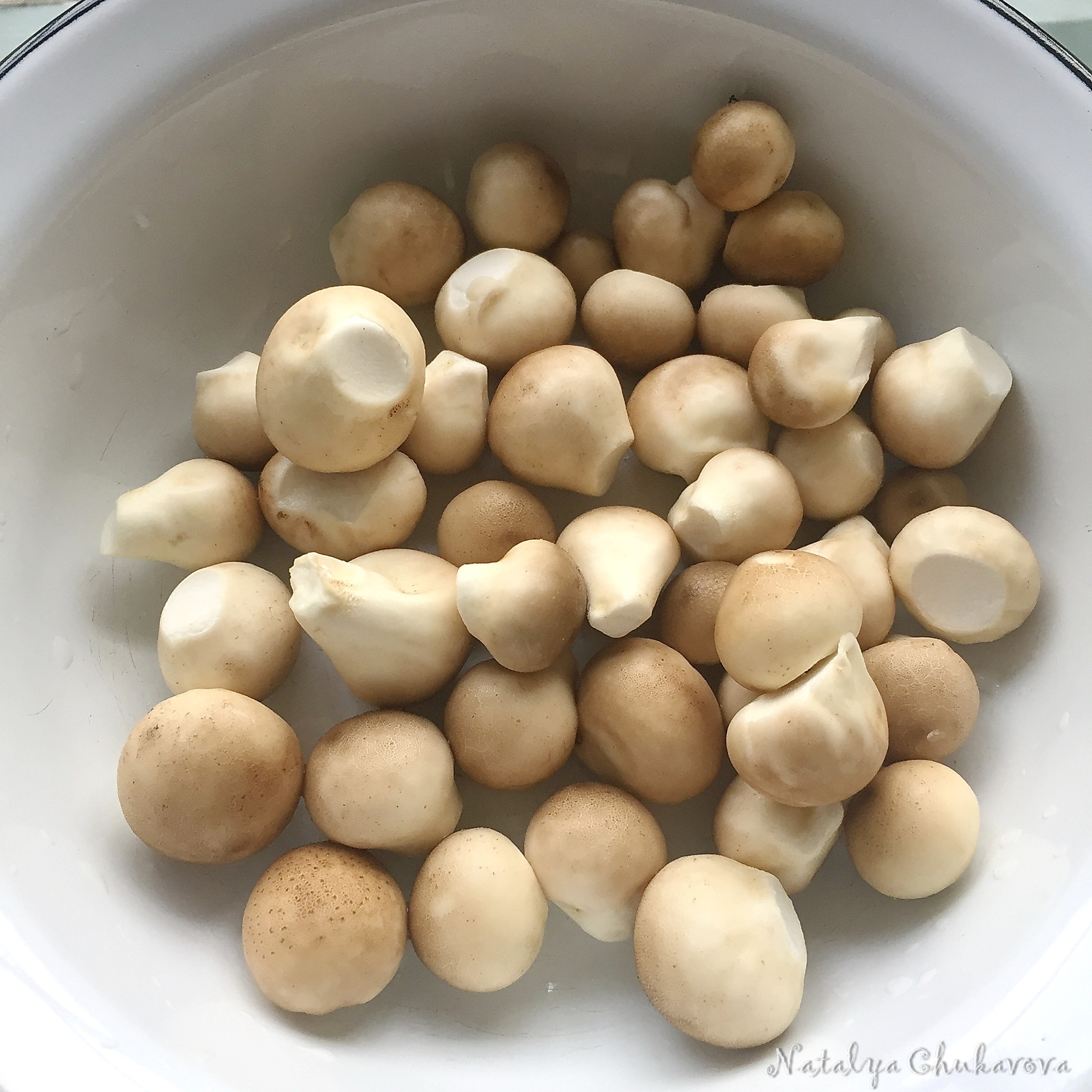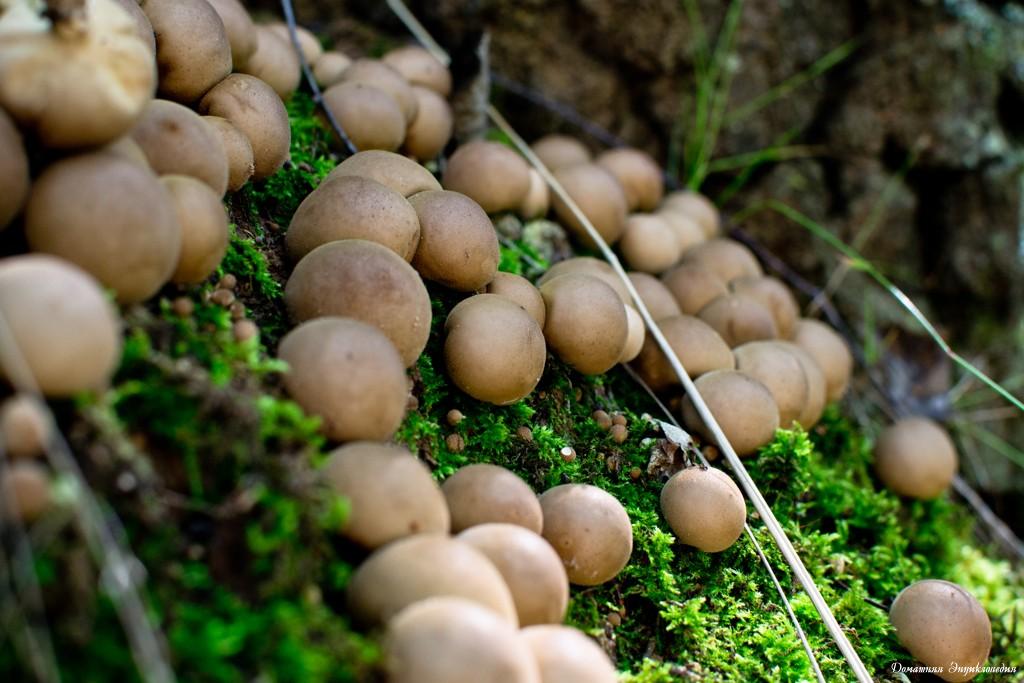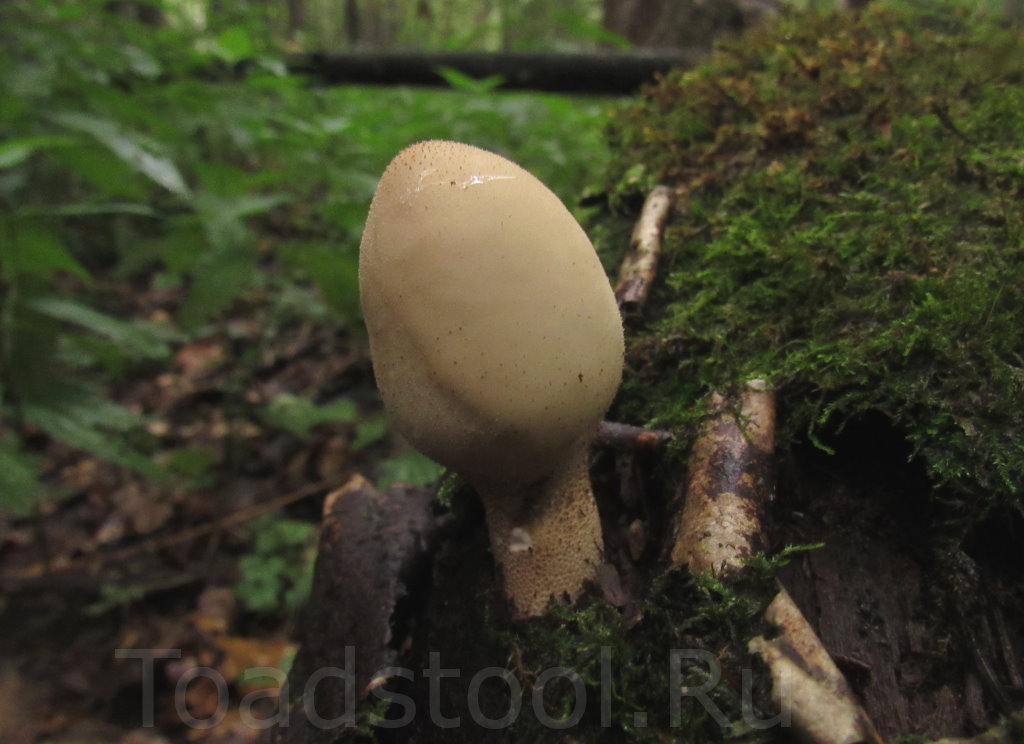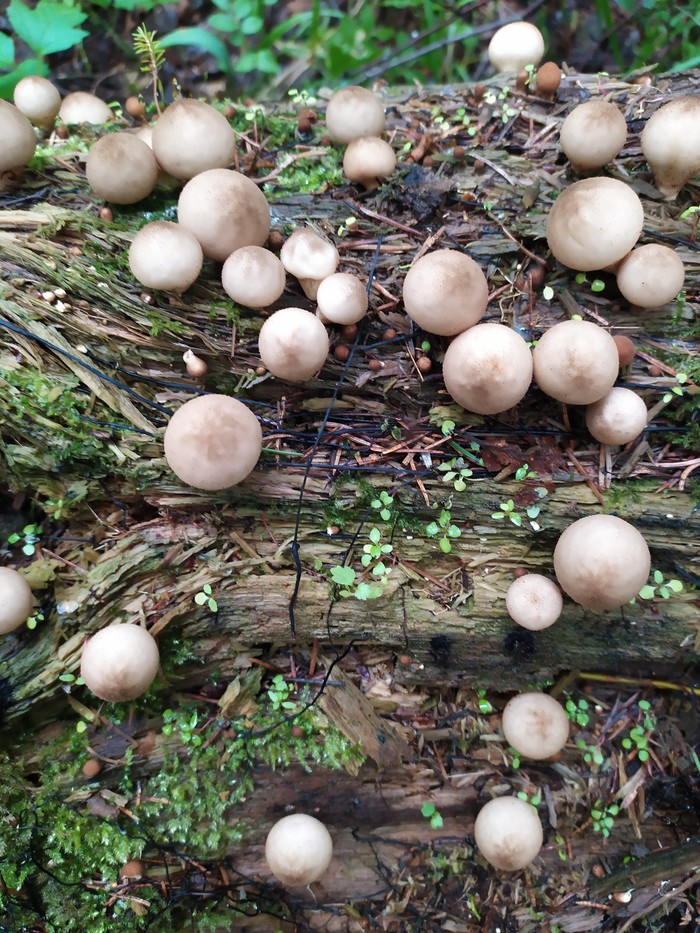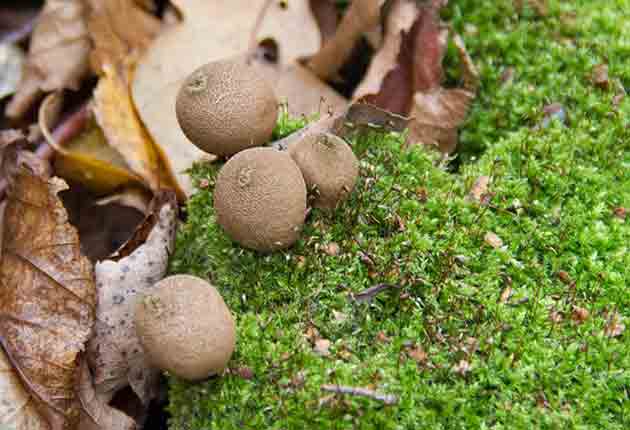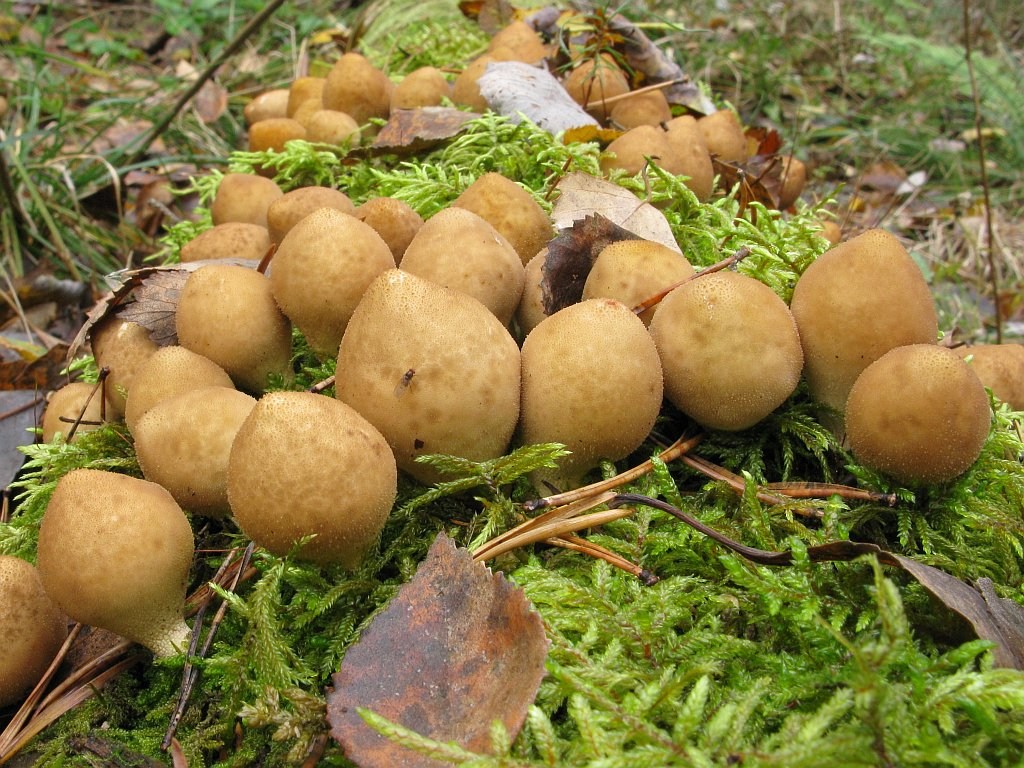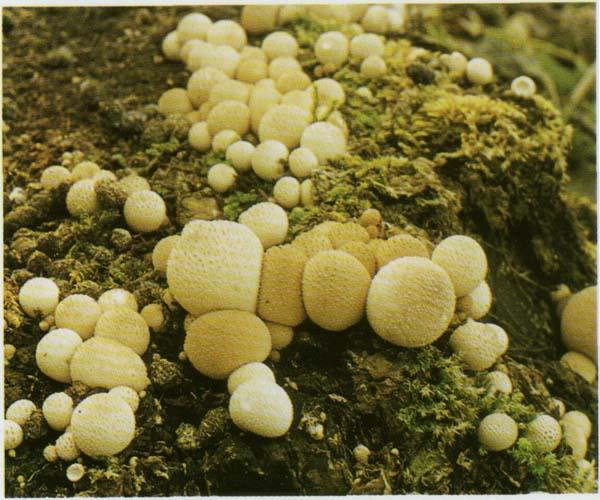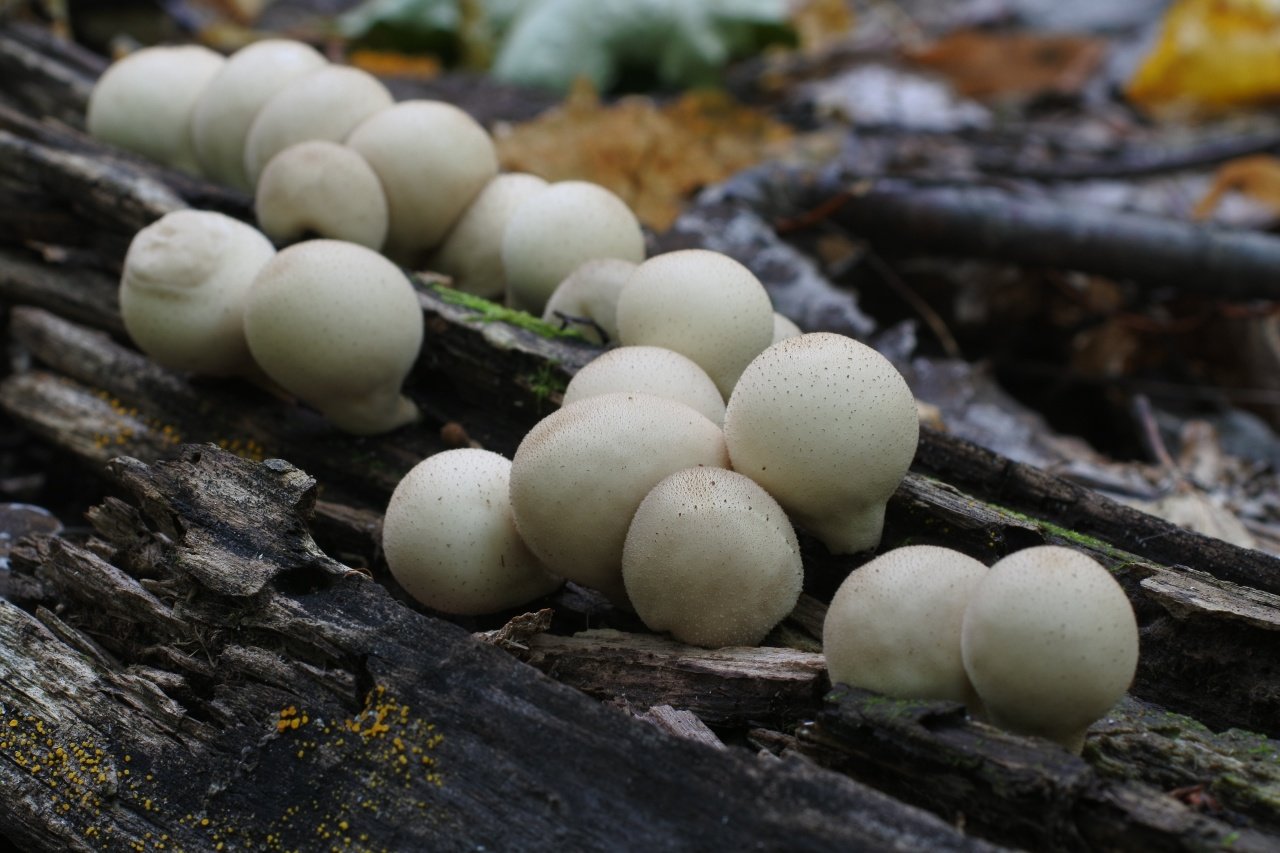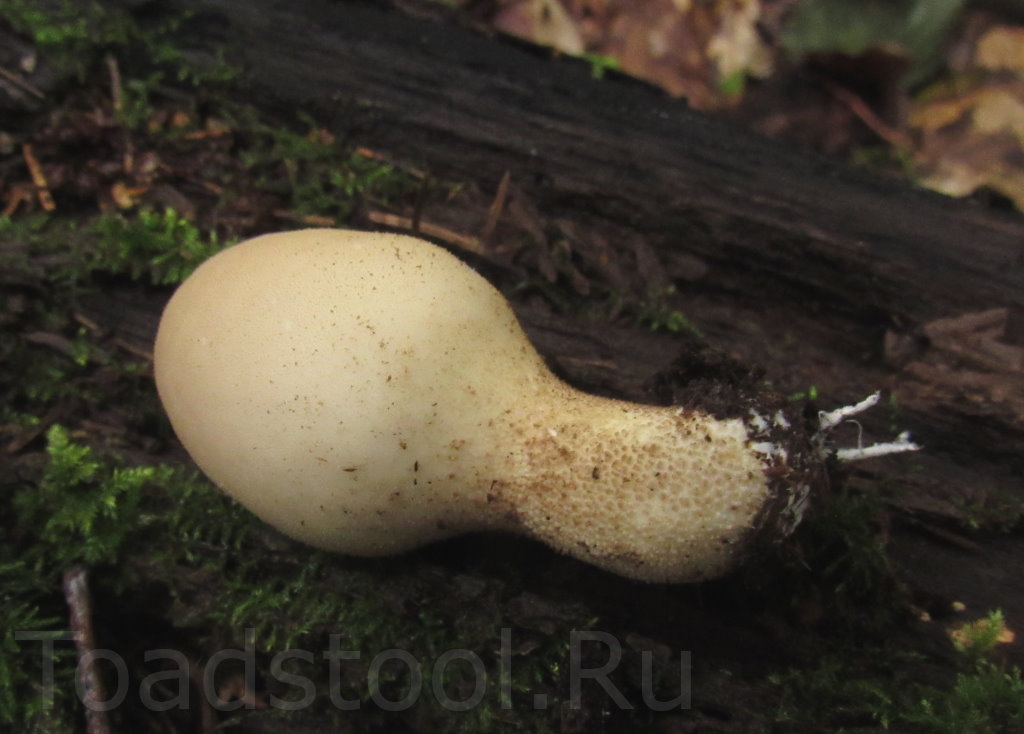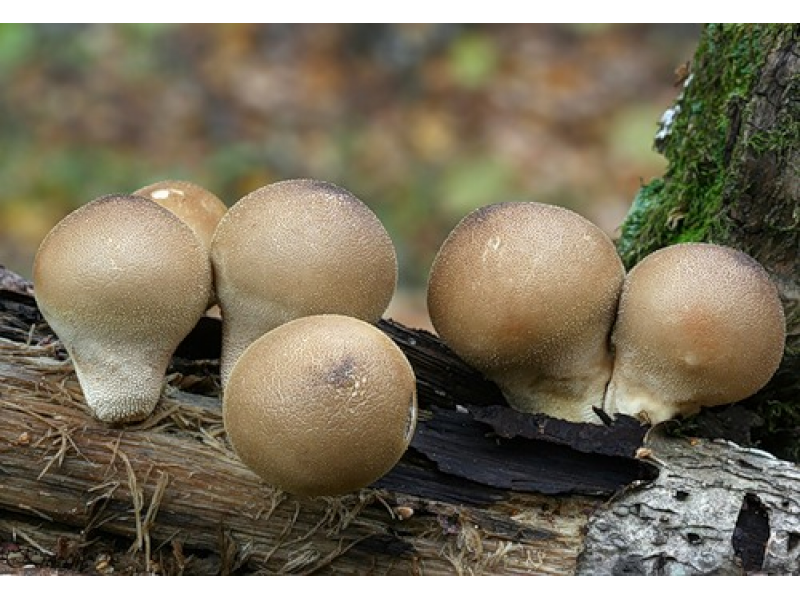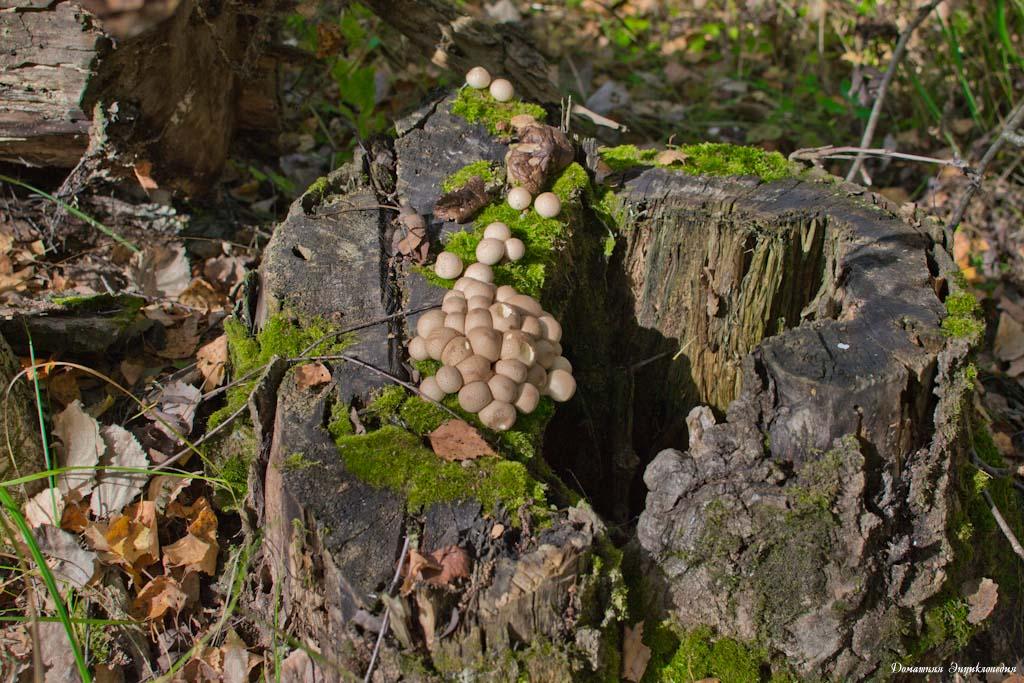Scleroderma
A pseudo-raincoat (scleroderma) is not worth collecting. In most books of the Soviet period, this mushroom is considered inedible or poisonous. Western authors call it only inedible, specifying that cooks sometimes add pulp to sausages instead of truffles. They all warn that the mock raincoat can be hazardous to health if eaten in large quantities.
I have not tried this mushroom, so I can only refer to the opinions of reputable mushroom experts. I quote them verbatim.
We conclude: the degree of poisoning with pseudo-raincoats depends, first of all, on the amount of mushrooms eaten.
False raincoats are easy to distinguish from edible species. False raincoats usually have a warty-scaly, dense skin of a yellowish-ocher color, on which there may be small cracks. In old mushrooms, the skin dries out, breaks and no longer holds the spores that are under it.
False raincoats often grow in nests (photo from Wikipedia)
The color of the flesh in young mushrooms, according to the writings of most authors, is yellowish or light olive even at a young age. A marble pattern with white veins can be seen on it. The central part of the pseudo-raincoat darkens as it grows, becomes first gray-violet, then almost black. The pulp of even adult pseudo-raincoats remains firm. Everyone notes an unpleasant, pungent odor.
For mushroom pickers who have not previously collected raincoats, it is better not to take risks and not pick mushrooms with elongated false legs that grow in nests. For safety reasons, it is better not to take raincoats with clearly yellow or brown skin. Especially when it is covered with rough growths and has noticeable cracks. An unpleasant smell should also stop.
Description of the pear-shaped raincoat.
The fruit body has a pear-shaped shape, while the "pseudo-leg" is very clearly expressed, but sometimes it hides in the moss, which makes the mushroom appear round. The diameter of the fruiting body in the thickened part is 3-7 centimeters, and the height reaches 4 centimeters.

The color of the fruit body in youth is light, almost white, but as it grows, metamorphosis occurs, and the mushroom becomes dirty brown. The surface of the fungus at a young age is prickly, and later it becomes smooth, often a large mesh appears, with a hint of cracking of the skin. These mushrooms have a thick skin and with age they easily peel off like a boiled egg.
Mushroom pulp has a faint taste and an indistinct smell. The flesh of young specimens is cotton-like, white in color, but over time a reddish-brown color appears, and later it completely goes to spores. The color of the spore powder is brown.

Reproduction of a pear-shaped raincoat.
When the pear-shaped slicker is ripe. Then, like other members of the family, the upper part opens up, and spores are released from there. They scatter in the wind and germinate in a new place, this is how these mushrooms multiply.

Places of distribution of pear-shaped raincoats.
Collect a pear-shaped raincoat from July to September. Fruiting occurs smoothly, without pronounced cyclicality. These mushrooms grow in groups, and they are dense and numerous. Pear-shaped raincoats settle on well-rotted wood remains; both coniferous and deciduous species are suitable for them.

Distinctive features of pear-shaped raincoats.
A distinct pseudopod and growing in large groups on rotting wood make it possible to easily distinguish this species from other members of the genus.
Pear-shaped raincoat (Lycoperdon pyriforme)
Habitat: on rotting wood in forests, parks and gardens, grows in large groups.
SEASON: August - November.

The hat has a diameter of 1-4 cm.A distinctive feature of the species is the pear-shaped form of the mushroom, creamy-white at a young age and ocher-brown at maturity. Young raincoats are covered with small darkish grains or warts; with age, the surface becomes smooth, and even later it darkens and a rounded hole opens at the top for spore powder.
The stem is tapered, with a thinning at the bottom, the length of the entire mushroom, including the stem and the spherical cap, is from 2 to 5 cm. There are strands at the base of the stem that ensure firm fixation of the mushroom to the wood.
Flesh: In young mushrooms, it is hard and white, but with age it becomes olive brown and flabby.
Plates. The leg in the upper part immediately passes into the cap, so there are no plates as such.

Variability. The color of the cap changes with age, and there is a successive color change from white to brownish, to ocher brown, to dark brown.
Similar species. The pear-shaped raincoat is similar to the prickly raincoat (Lycoperdon perlatum), which differs in the shape of the leg - not conical-pear-shaped, but cylindrical, smoothly turning into a spherical cap.
Edible: only young mushrooms with dense pulp are edible, when the color of the surface is still light, the mushrooms are boiled, fried.
Edible, 4th category.
Share link
How to prepare a raincoat?
I love this mushroom. However, I take only smooth young white "balls". The pan of fried raincoats is a delicious and satisfying food. This mushroom tastes a bit like something in between mushrooms, scrambled eggs and ... chicken meat. The protein flavor is enhanced if the slicker is fried with butter or ghee.
I don't like boiled raincoats, but fried ones. They can be cut into pieces, slices, or slices and placed in a skillet with butter. Sometimes, before frying, large slices up to 2 cm thick are rolled in flour or breadcrumbs. They can be seasoned with salt and even pepper. Whole balls fried in oil are also tasty. First, fry on one side until a beautiful golden brown crust, then turn over or roll to the other side. It takes a little time. Especially if you fry the mushroom in a skillet under the lid.
It is worth saying that almost all raincoats have a skin that resembles either a skin or an eggshell. It's better to take it off.
V.A. Soloukhin described in detail the state of a man who always considered all raincoats to be toadstools:
Let's once again appreciate the culinary merits of the giant raincoat, while its flesh is pure white in color. During this period, the mushroom competes with the noble mushrooms themselves. The "ball" is peeled and fried, soup is boiled from it and dried. Other raincoats are also suitable for drying, even pearl ones.
V.A. Soloukhin quotes one of his readers who not only describes the method of preparing raincoats, but also compares the methods of processing them:
Podmoskovye website, 2012-2019. Copying texts and photos from the site pоdmoskоvje.cоm is prohibited. All rights reserved.
Remember grandfather's tobacco? I'm talking about mushrooms, familiar to many from childhood. And this is an article about them
Greetings, my dear readers. In this article I would like to tell (and remind many) about mushrooms that brought laughter and joy to some of us in childhood ...
Personally, I saw, remembered and even smelled them (did I break anything in the Zen rules?) Back in the distant 70s of the last century. In those days, children were taken out not only to pioneer camps. For the younger ones, there were also camps in the forest, where they went together with a kindergarten group and a teacher.
There were few of them, of course, and not everyone was lucky to be there ... I was. And there is something to remember. We went to the forest 2 times a day. Yes, what is there to walk? If he was right behind the fence. More precisely, he was in our territory. But somehow we did not call these trees - forest.
And there are a lot of mushrooms in the forest. And I was no more than 4-5 years old. But I remember ... I remember how they plucked these ripe raincoats, squeezed them with our fingers and “smoked” them.They themselves did not think of this, they would, of course, but apparently, one of the older children suggested.
It was considered special chic when they brought these mushrooms to the camp, and after dinner, sitting on a bench and crossing their legs, they held and squeezed a raincoat near their mouth, making it “smoke”. And they said: “Don't bother. I smoke!" This is how far the imitation of adults went ...
Edible raincoat (Lycoperdon perlatum).
It is also called a prickly, pearl, black or needle raincoat. It belongs to the Champignon family, the Raincoat genus.
It has many more names, which is very strange, given the low popularity among mushroom pickers.
A young, dense fungus that does not have a powdery mass of spores is called a hare potato or a bee sponge. A ripe or overgrown mushroom is called a dust collector, flap, grandfather's tobacco, tobacco mushroom.
This representative of the mushroom kingdom is familiar to many from childhood. Remember - this is the same mushroom raincoat that, when damaged, makes a peculiar sound and emits a mass of grayish dust. However, only mature fruiting bodies "behave" in this way. Young ones, on the other hand, are white, beautiful and appetizing.
WHAT IT LOOKS LIKE:
Fruit body: up to 8 cm in height, white, yellowing by old age, capitate, with a well-developed cylindrical false stem. Head up to 4 cm in height, up to 5 cm in diameter. Its surface is covered with spines or small warts.
Leg: up to 5 cm in height, up to 3 cm in thickness, folded and pitted.
The flesh: young mushrooms are white, mature ones are gray-brown, without a special smell and taste; by old age it breaks down in the head and forms a huge number of spores in the form of light brown dust.
The spore powder flies out through a hole that appears at the site of the former cap tubercle. In order for the spores to fly up into a cloud of dust, it is enough to touch the mushroom.
SPREAD:
These mushrooms grow in deciduous and coniferous forests, in pastures and meadows from the beginning of summer to the end of autumn, after a good rain. Active mushroom time is from August to September.
SIMILAR SPECIES:
- Golovach oblong. The head does not form a hole at the top. The tops collapse, and only sterile legs remain in their place.
- Pear-shaped raincoat. In contrast, the fruiting body of the edible raincoat is covered with small thorns.
- Inedible smelly raincoat (Lycoperdon foetidum), which has brown curved thorns on the fruiting body, and young mushrooms have an unpleasant odor.
EDIBILITY:
According to Italians, dust makers are one of the most delicious mushrooms, especially those fried in slices. The main thing is to catch them at a time when the pulp is still loose and white. You can, of course, believe them. But the Italians do not recognize any of the types of boletus, considering them poisonous. But with this, my soul cannot come to terms!
In general, it is used boiled, fried and dried. When dried, the mushroom does not darken. Only young white fruit bodies with firm white pulp are used for food.
Several years ago I happened to eat soup from these raincoats for several days in a row. Impressions: Quite a decent first course. Transparent (like porcini mushrooms) and very satisfying.
By the way, grandfather's tobacco also has medicinal properties. In folk medicine, it is known as a good antineoplastic agent, recommended for anemia, eczema, and digestive problems.
A raincoat is also used to stop bleeding, to relieve inflammatory processes. It cleanses the body and is used in cosmetology, improving the condition of the skin.
THANKS TO ALL WHO READ !!!
Healing properties
In terms of protein content, raincoats are superior to porcini and champignons.
Fruiting bodies contain leucine, tyrosine, ergosterol, lipoids, and various enzymes.
Galvic acid, formed by raincoats and bigheads, inhibits the development of many bacteria and fungi, and also has an antitumor effect.
Many substances with an antibiotic effect are made from galvic acid by chemical synthesis.
Since ancient times, raincoats were used to treat kidney diseases and purulent wounds.
If in the forest you have received damage in the form of a cut, then the best hemostatic agent is a raincoat or a bighead. For these purposes, only young specimens are taken, which are still dense inside, washed and cut or broken, then applied to the site of damage. As a result, bleeding stops and suppuration does not occur.
In the form of an infusion or decoction, it is used as an external hemostatic, antiseptic and anti-inflammatory agent.
Spores are used in homeopathy.
Used to treat kidney disease.
Strengthens the reproductive glands.
Contraindications for the use of pear-shaped raincoats.
Raincoat mushrooms do not have poisonous counterparts, so you should not be afraid of poisoning, but it should be borne in mind that they are suitable for use in cooking only at a young age. It should also be remembered that raincoats can absorb toxic substances from the soil and from the air, so you cannot collect them in the city.
Related species.
A ragged raincoat, like a pear-shaped raincoat, is edible. This is a rare type of raincoat and one of the most beautiful representatives of the genus. The shape of its fruiting body is inversely pear-shaped. The entire surface of the mushroom is dotted with white cotton-like flakes. In the process of growth of the fungus, its cover breaks up into small patches lying on small spines. The color of the fruiting body can be light cream or ocher brown.

Pear-shaped raincoats bear fruit in small groups or singly. This species is found in areas with a warm climate. Places of growth are oak and hornbeam forests.
Baggy golovach is another edible raincoat. The shape of the fruit body is round, flattened from above, and narrowed downward. The surface of the fungus is fine-grained. At a young age, the bighead is light, and later becomes gray-brown. The pulp with a pleasant smell, first white and then brown.
Baggy bighead bears fruit from May to September. This species prefers to settle in meadows, forest edges, pastures. Fruiting does not occur often, in single specimens.
The benefits of pear-shaped raincoats.
Raincoats are not very popular among mushroom pickers, but they have useful properties and are of great medical value. When consumed regularly, they flush out toxins. In addition, they contribute to the release of heavy metals from the body, that is, they reduce the risk of developing cancer. Pear-shaped raincoats can be called a preventive measure against cardiovascular diseases. They also help get rid of worms.

Raincoats have earned a good reputation in cosmetology as well. Creams and masks based on raincoats give an excellent effect: they make the skin noticeably taut, elastic and smooth, get rid of oily sheen, reduce pores, and improve complexion. In addition, raincoats can improve eye color - they cleanse the whites.
Botanical description
In a raincoat, the cap and the leg form one fruiting body. It, depending on the species, reaches various sizes and weights: from a few grams to two kilograms. Shape: round, ovoid or pear-shaped. The surface of the dust collector can be white, grayish-white or yellow, sometimes covered with warts or small thorns. The white pulp, as it ripens, shrinks and transforms into a dark spore powder, which is released through a hole in the crown of the mushroom and spreads through the air. The body of an adult tobacco fungus is covered with a two-layer shell. The inner shell is leathery, and the outer one is smooth.
Edibility
A raincoat is an edible mushroom, but due to its personality, some peculiarities must be considered:
- If the cut is the pulp with a yellow or green tint, then such a mushroom is not suitable for eating. It should be firm, pure white, uniform and firm.
- It is only necessary to collect young mushrooms. This representative of the mushroom kingdom is aging rapidly. And such fruiting bodies are no longer suitable for consumption.
Edible types of raincoats:
Giant.The giant or bighead (Langermannia gigantea) is a huge ball, but sometimes it can be a little flattened. The weight can be up to 8 kg. Covered with smooth or flaky skin. In an adult mushroom, the color changes from white to dirty green. The pulp is crumbly. This is a rare species and is not often found in the middle lane. Grows in meadows, fields or old pastures; can be found in deciduous forests.
Pear-shaped (Lycoperdon pyriforme). The name comes from the shape of the fruiting body, which looks like a pear. Its thickest part reaches about 7 cm in diameter and about 5 cm in length. The young body of a milky color is covered with a double shell, from which a small false pedicle departs. The outer layer is prickly, covered with cracks or scales. In an adult fungus, the thorns fall off and this layer begins to crack. The inner gray-brown or yellowish membrane opens, which closes the spores. They penetrate through the holes on the top of the raincoat after ripening.
Thorny (Lycoperdon perlatum). Also known as pearl, black, or needle-like. The shape is pear-shaped, slightly flattened. They grow from 2 to 7 cm in diameter and up to 4 cm in height. The skin is covered with small thorns or warts. Initially white in color, and over time - gray and purple-brown, which is already a sign of unsuitability for food. Harvesting begins in early July and ends in early September.
Elongated golovach (Calvatia excipuliformis). Outwardly, it resembles a bubble pulled to the bottom. It looks smooth, but on closer inspection, you can see that it is covered with inconspicuous, delicate, thin spines. The flesh of a young mushroom is white, an adult is dark, sometimes almost black. Mushroom pickers are often confused with pseudo-raincoats because of the combination: the absence of pseudopods and the presence of needles.
Lugovoi's raincoat (Lycoperdon pratense or Vascellum pratense). White spherical shape, which flattens and turns brown over time. Small sizes from 1 to 6 cm in diameter and from 1 to 5 cm in height. Has a wrinkled pseudopod. It grows mainly on forest edges, meadows and glades. Used only at a young age.
In addition to edible species, there are also false ones:
Warty slicker (Scleroderma verrucosum). The poisonous representative of the tuberous form is yellowish-gray, and over time, light brown, with hard and thick skin. Up to 5 cm in diameter. The complete absence of the leg is characteristic. Combined, the aroma can be compared to the smell of raw potatoes and herbs.
Raincoat Ordinary or orange (Scleroderma citrinum). The fruiting body is up to 6 cm in diameter. Form - tuberous, smooth. The shell is thick, dirty yellow or brown in color with small scales in the upper half of the mushroom. The pulp is white, but when ripe it turns black with white fibers. The smell can be compared to a truffle.
Spotted, panther or leopard sclerodema (Scleroderma areolatum). Mushroom pear-shaped or spherical. The diameter is from 1 to 5 cm. The leg is absent. The skin is smooth and thin. White or cream color, at a more mature age changes to brownish yellow. The leopard print is created by small scales scattered over the surface, with characteristic rims. The white flesh, as it ripens, changes to greenish brown or dark purple with white veins. The smell is sweet.
Variety of species
Even a seasoned mushroom picker is not always familiar with complex taxonomy. This applies to many mushrooms, including raincoats.
Raincoats, porkhovka and bighead belong to the group of gasteromycetes ("nutreviks"), because their fruiting bodies remain intact until the time of spore maturation. The membrane then ruptures, resulting in the release of "smoke" with spores. These mushrooms are referred to as saprophytes, because they need rotted organic matter for nutrition.
Here is a brief description of several mushrooms that we call "raincoats". They are all delicious. They are harvested young as long as their fruiting bodies are firm and filled with white flesh.
Thorny raincoat (Lycoperdon perlatum) is covered with well-visible conical needles.If you peel them off from a white or creamy skin, then a more or less noticeable mesh pattern will remain on it. The smell of the mushroom is pleasant. This type of raincoat can be safely put in the basket while the mushroom is young and strong, and its flesh is white and firm. The fungus often grows in groups.
The pearl puffer (Lycoperdon perlatum) prefers manured pastures, although it is also found in forests. The pearl raincoat grows (more often in waves) from May to mid-November. This mushroom has a pear-shaped white fruiting body, which turns yellow as it matures, then becomes gray-brown. Old mushrooms are filled with spore powder inside. The skin has small growths or thornless spines, which are sometimes found only in the upper part.
This is a very beautiful and delicious mushroom (photo from Wikipedia)
The oblong head (Calvatia excipuliformis) in some reference books is called a type of prickly raincoat. However, the bighead is taller, its thorns are softer and thinner, it is edible at a young age. Sometimes the mushroom resembles a bubble in shape, which is inflated with air and pulled from the bottom (the head is saccular, or bubble-shaped). These mushrooms often grow in pastures.
The appearance of the giant raincoat, or the giant Langermannia (Langermannia gigantean), is striking. In some publications, he is ranked among the golovacs. It is a huge mushroom. It grows in forests (deciduous and mixed), meadows, fields and pastures. More chances to find it from the end of summer (August - October). The huge "soccer ball" can weigh up to 8 kg and is 40 cm across. Some record-breaking specimens are known that weighed almost 20 kg and had a fruiting body diameter of 30 cm !!! More likely to find a giant pound raincoat the size of an average cabbage head.
The skin of this slicker jacket can be either smooth or slightly flaky. As it grows, the color of the pulp changes from white (or slightly yellowish) to greenish-brown, then to dirty brown. In old mushrooms, the skin dries up and resembles parchment. The edible pulp is often loose, resembling homemade cheeses in consistency. As it grows, the mushroom becomes lighter, noticeably losing weight. The mycelium of the giant raincoat is durable, it can live up to 25 years.
Pear-shaped puffer (Lycoperdon pyriforme) refers to small species (up to a maximum of 5 cm in height). It often grows on rotting wood, tree trunks and stumps. The shape of the fruiting body is pear-shaped, resembling a white ball narrowed downwards, which has a short false stem with rare light filaments of mycelium. This delicious mushroom is fried and boiled (in soups), unless it is overripe. The degree of maturity can often be determined not in the forest, but in the kitchen, because when ripe, the mushroom does not always quickly change the color of the skin.

